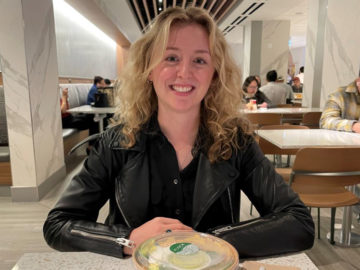Teens & College
The Food Allergy Girl – Who Nobody Gets
I have Eosinophilic Esophagitis, a serious food allergy that almost nobody knows about. It's complicated to explain this life-altering condition to friends and restaurants. Thankfully, I am getting better at it.
When I was a little kid, I was in constant pain. My stomach hurt every, single day. My mom has a strong memory of me with my distended belly, of how I felt sick every time I ate. She recalls how I’d double over the arm of the couch many evenings, hoping that pressure would bring some relief.
The truth is, we did everything so I could feel better. But in those early days, nothing worked. I underwent innumerable tests, had some great and some dismissive doctors. Then finally, I was diagnosed with Eosinophilic Esophagitis (EoE) when I was 3 years old.
Eosinophilic Esophagitis. What? How do you even pronounce that? How do you spell that? And how do you take care of that? Certainly, I didn’t know. What can I say? I was only 3 years old!
Fourteen years later, I finally do know. Eosinophilic (e-o-sin-o-FILL-ik) Esophagitis is a condition that impacts the esophagus. With this condition, white blood cells called eosinophils accumulate in the lining of the esophagus, and release substances that can cause inflammation and even scarring. In severe cases, this can lead to food impaction (where swallowed food gets firmly stuck in the narrowed esophagus) and choking. That sounds really, really scary. Obviously, nobody told me all of this when I was 3, but I can’t imagine what my parents thought.
In the same year as my EoE diagnosis, my sister, then a year old, was diagnosed with severe food allergies. All at once, my family became known as the “allergy family.” We would become each other’s greatest advocates, not because we wanted to, but because we had to. To be frank, it was very difficult, and sometimes it still is. We’re all used to our lifestyle of food vigilance now, but it was quite the adjustment.
Eosinophilic What?
This may sound odd, but I was always slightly envious of my sister. No, I did not want her life-threatening food allergies, but I saw how quickly outsiders gained at least a basic understanding of her condition. That made me feel jealous. I couldn’t even comprehend what I had, so how could I expect others to understand?
First, I learned the acronym: EoE. That was all I knew until I was 7 years old. When someone asked me what condition I had or why I was feeling sick, all I could say was “I have EoE,” and move on. If I was lucky enough for my mom to be with me, I would turn to her and ask her to explain. I couldn’t do it myself.

Then, I learned what was actually happening in my esophagus, but very vaguely. I knew there were white blood cells in my esophagus, that they could cause scars. I knew that sometimes it felt like food was stuck in my throat, and that my stomach still always hurt. All I could tell my teachers or my friends was that my stomach hurt, because that was the worst part. But what I didn’t know was the exact definition, or how to explain my form of food allergy in a way that everyone would understand.
When I was 10, I finally mastered how to spell Eosinophilic Esophagitis. Yeah, it took me seven years. It includes some intense spelling!
Just as I learned how to spell my condition, everything changed. My new doctor decided it would be best if I tried removing foods from my diet. We started with gluten. Suddenly, I was making the first big change that not only affected me, but also everyone who wanted to serve me food. When they asked, “Why can’t you eat gluten?” I still couldn’t find the right things to say.
Imagine asking a toddler to talk about her day. She babbles on and on about something that only makes sense to her. That was probably what I sounded like. I could list my symptoms, I could name my condition, but I couldn’t explain it in a way that was universally understood.
Remission, Then Return
Not much has changed in that respect. I still can’t quite find the watered-down definition of EoE that makes sense to strangers, but also sounds scary enough to make them take me seriously. My diet, however, has certainly changed – I stopped eating dairy when I was 12, and I was able to add gluten back when I was 13.
Dairy was allowed back in my diet after a food trial when I was 15 proved that I was in remission for my EoE. That was a period of great relief. But as of last week, I am no longer in remission. The EoE has come back. My new (old) diet to control the crippling stomach pain consists of no dairy and no caffeine.
It’s hard to talk about this form of food allergy. I can never find the right things to say. I wish it was as easy as saying, “If I eat this food, I will go into anaphylaxis.” Even though that is another level of terrifying, at least it is understandable.
I’m working on the communication challenge, though. I know I’ll figure it out soon enough. Every time someone asks me about eosinophilic esophagitis, my explanation makes a bit more sense. I’ve become more succinct with time, and I hope I can continue this trend.
I’m determined to figure out how to tell others in a way that makes my condition more real, less obscure, and helps bring it some awareness. It just might take another 14 years. I’ll be the patient patient.
Elaine Kelly, 17, is a high school senior in Long Island, New York, who is looking forward to college. This is the second of two articles on life with food allergies by the Kelly sisters. First article: Cara Kelly, 15, gives a teen’s candid take on life with severe nut and peanut allergies.
Related Reading:
Teen Life with Food Allergies: The Struggle is Real, But Getting Better
Blood Test to Diagnosis EoE Triggers? Researchers Make Progress
Ask the Allergist: Helping a Child with the Difference Between IgE Allergies and EoE


